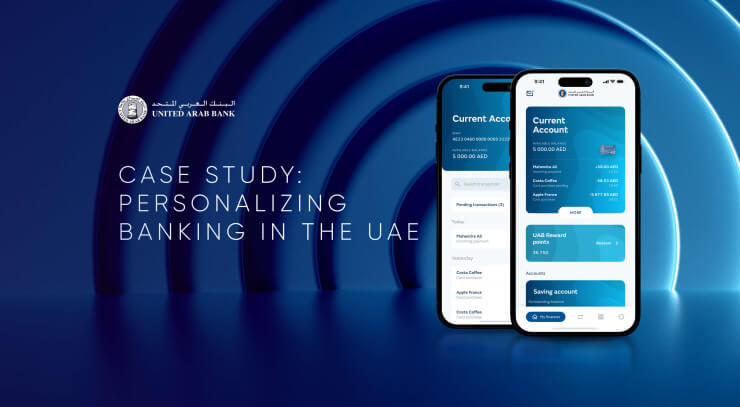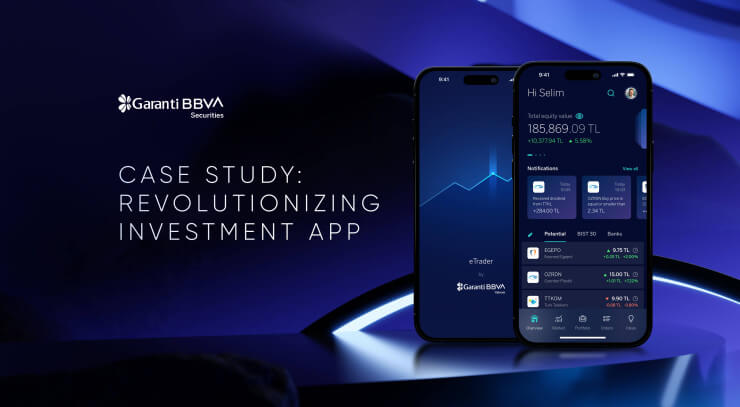In today's competitive financial landscape, exceptional user experience (UX) is not just a differentiator—it's a must. Financial apps and services can either simplify our financial lives or add to our stress. Understanding the psychology behind user behavior is crucial for designing products that are not only functional but also engaging and stress-free. This article explores the key psychological principles that can transform financial UX design from a source of frustration to one of satisfaction and loyalty.
The Importance of Psychology in Digital Banking UX
Banks and fintech companies constantly innovate to attract users. However, innovation alone isn't sufficient. Users, having experienced high-quality products, expect the same standard across all services, including banking. Thus, the core of an exceptional financial product lies in its user-centric design, informed by an understanding of human psychology. And having designed more than 150 financial apps in 37 countries over 9 years, my team can assure you that the fundamental laws of psychology work for people of any nation, age and income.
In fact, to have a better vision and create a user centered design that will have a positive impact on their users, UX professionals should use proven psychology studies that strongly state facts about the way users perceive certain elements of the interface, their behaviours and reactions. Psychology plays a critical role in helping banks better understand and serve their customers, which is essential for the long-term success of any financial institution.
Psychology is important in banking for a number of reasons:
- Predicting Consumer Behavior. Psychological insights enable the prediction of user behavior, allowing financial institutions to design products that cater precisely to user needs and preferences, thereby enhancing satisfaction and retention.
- Enhancing Product and Marketing. Applying psychological principles can create more effective business, product and marketing strategies that resonate deeply with consumers, driving higher engagement.
- Improving Customer Service. By understanding how users think and feel, banks can develop customer service processes that effectively address user concerns, improving satisfaction and loyalty while reducing friction.
It is not easy for people to deal with finances, often conjuring up negative emotions. In fact, some people are even terrified to access their digital bank to view their balance. The finance environment causes stress and even sleeping disturbances for 65% of Americans, as stated in a 2017 study by CreditCards.com.
Moreover, another survey from PricewaterhouseCoopers (PwC) claims that the group of people who report the most stress about finances are millennials, since 42% of them have student loans, and 79% state that “their student loans are having a moderate or significant impact on their ability to meet their other financial goals.
Due to the fact that finances are such a stress-provoking issue for most people, it is important to know what can be done to improve this situation. What are the key financial pain points for people, and how can they be addressed with the right financial products? How can we change the relationship between humans and finance and turn it into something pleasant?
Ten Psychological Laws that Will Improve the UX of a Financial Product
A big step towards providing a positive financial experience entails not only offering cool product features and nicely-designed banking functions, but taking a deeper look into the ones who will be using the financial product as a part of their daily lives. The basis of this human-centered approach is the exploration and understanding of the human mind, psychology and mental habits.
We know that technologies develop rapidly, and new solutions are introduced to us daily, but what doesn't change is the way people perceive the world, think, behave, make decisions and feel. Although undoubtedly affected by the times, these fundamental principles have been developing within us since the beginnings of human existence, and they remain generally the same.
Knowing that, I want to go through some of the key studies, proven facts and user researches that were conducted specifically for the exploration of the psychology of the human mind and understand how these rules apply to financial UX design.
1. Jakob's Law for UI Consistency
Jakob's Law, introduced in 2000 by usability expert Jakob Nielsen, states: “Users spend most of their time on other sites. This means that users prefer your site to work the same way as all the other sites they already know.” This principle emphasizes the importance of familiar UI elements and scenarios, which reduce the learning curve of a new application.
Understanding finance can be challenging for many people. If banking product designs use unfamiliar approaches, different paths, and uncommon element placements, users' cognitive load will increase, significantly extending their learning curve.
The concept of the learning curve was first described by German psychologist Hermann Ebbinghaus in his 1885 book, Memory: A Contribution to Experimental Psychology. Subsequent studies have confirmed that repetitive performance of the same task leads to improved speed and efficiency. As noted by Jakob Nielsen in a 2009 article, people generally dislike change.
Consider logging into your online bank account to quickly pay a utility bill. We've all experienced the desire for a quick and painless process. In such situations, users appreciate a design that offers a stress-free experience with familiar, intuitive content and easily recognizable features.
People prefer making transactions effortlessly in familiar environments. This level of simplicity and user experience is now highly expected from banking and fintech applications.
2. Leveraging Mental Models
You have probably been in a situation in which you have to use a new product and expect it to be complex. You might be thinking: This is new for me, and I probably will not know how to use it. But, unexpectedly, it turns out to be the total opposite─everything is simple and understandable, and you don't even need any additional help. However, what if that situation was different? You expect something to be understandable and familiar, but it turns to be completely different and just does not feel right. In this case, the product was created without taking your mental model into consideration. The smaller the difference between how you expect something to work and how it actually works, the more user friendly and intuitive the design is.
When we imagine digital banking interfaces, we often assume that they are difficult, boring and frustrating, and, unfortunately, quite often digital banking platforms do fall behind other modern services. If we compare digital banking to popular, highly-used and well thought-out services, banking interfaces often do not tend to result in pleasant and intuitive experiences for their users.
A 2018 survey from D3Banking showed that 68% of digital banking users in America are frustrated with their banking experience. In reality, this is one of the main results of not thinking about the mental models and overall experiences of digital banking users.
The foundation for the concept of mental models was first described in the 1943 book, The Nature of Exploration by Kenneth Craik, a Scottish psychologist and one of the earliest practitioners of cognitive science. In his book, the author states that the human mind creates “small-scale models of reality” and uses them to predict similar events in the future.
In other words, a mental model is a representation of what a person has in mind, before using a new object for the first time. The model isn't based on known facts about the object, but rather on beliefs, expectations and assumptions, as well as the previous experiences and things the user has heard about it.
We are all familiar with Occam's Razor, the problem-solving principle that the simplest solution tends to be the right one. When presented with competing hypotheses to solve a problem, one selects the solution with the fewest assumptions.
What model do your customers’ minds create when they think about opening and starting to use a new banking app or website? Do you know what they imagine and expect to see? If they're new visitors, they likely expect to see an option to open an account. If they're already registered users, first and foremost they expect to see the elements that play the biggest roles within their financial lives, e.g. account balance, recent transactions and the ability to make payments and receive money.
When designing an intuitive digital financial experience, it is a great challenge for designers to create a match between the users’ perceptions and the banking UI design. As finances can be generally confusing for many people, it is important to understand the mental models of your target audience by conducting research about them. The fewer mismatches there are between the mental models and actual interface design, the less time it will take for users to learn and understand it.
3. Ensuring Explicit Responsiveness
Recently, I was filling out a travel insurance application on an internet banking platform. The form was lengthy with numerous fields and options, and it took longer than I anticipated. Upon completion, I received this feedback: “Your request has been received. Our operator will contact you shortly.” While it was good to know that I would receive a response, the feedback left me with several questions: How long would I have to wait? Was there anything I needed to do in the meantime? How would the response be delivered—via the banking platform, a phone call, or an email?
I expected some form of follow-up within 30 minutes, but after more than two hours, there was still no notification. I had plans to go to the theater that day, and I worried about receiving a call during the performance. This lack of clear communication caused frustration and left me feeling out of control because I didn't know what to expect or when to expect it.
Jeff Johnson, in his book Designing with the Mind in Mind, emphasizes that an interactive system’s responsiveness—its ability to keep users informed about its status and not make them wait unexpectedly—is crucial for user satisfaction. This principle is particularly important in designing a comprehensive and satisfying user experience in the finance industry.
Responsiveness allows users to understand what is happening and what will happen, fostering a sense of control.
For users of digital banking, continuous feedback is essential. When money is involved, people tend to be very sensitive and easily triggered emotionally. Users have their own time requirements and expect the system to synchronize well with them. Numerous studies, such as those by Robert B. Miller in 1968, A.J. Thadhani in 1981, and Avi and Sara F. Rushinek in 1986, have shown that responsiveness is the most important factor in user satisfaction, even more so than ease of use.
If banking interfaces cannot provide sufficient responsiveness for their demanding users, it will lead to frustration and drive them to seek better alternatives that meet their needs.
4. Optimizing Visual Processing
In our daily lives, we constantly encounter information through text and words. Whether it's an article headline, an email, or product details on a banking website, reading is an integral part of our routine. However, reading has not always come naturally to us. Moreover, the skills of reading and writing did not even exist around 3000 years BC. While the human brain evolved to naturally support spoken language and to see nature's elements around us, writing became common long after the brain had already developed into its modern state.
In user-centered design for finance, it's crucial to present information that users can easily understand. Financial information is often complex and needs to be communicated clearly and concisely. According to Tesler's Law, also known as the Law of Conservation of Complexity, every system has an irreducible amount of complexity. UX design's role is to manage this complexity by organizing data simply and effectively.
Banking apps contain vast amounts of data, which can overwhelm users. Poorly constructed information, filled with jargon and lacking visual aids, makes comprehension difficult. Visual elements play a significant role in improving user understanding.
The idiom "A picture is worth a thousand words" holds true; research by 3M in 1997 found that visual images are processed 60,000 times faster than text. The "picture superiority effect" shows that images are more memorable than words. Using icons alongside text engages the emotional part of the brain, enhancing communication.
Effective presentation of textual information involves several principles. When designing banking interfaces, prioritize simple and straightforward language over complex financial terminology. Use relevant images to support the text. Apply a clear hierarchy to structure information, making it easier for users to grasp their financial situation. Prioritizing and spacing information correctly enhances the user experience.
Another key principle is Miller's Law, which states that the average person can hold about seven items (plus or minus two) in their working memory. This means financial information should be divided into chunks, lists, and bullet points to improve clarity and retention.
By focusing on visual processing and applying these principles, financial UX design can make complex information accessible and engaging for users.
5. Applying Gestalt Principles
Users appreciate well-crafted, simple, and easily perceivable financial designs. A 2012 Google study found that people judge a website's visual appeal within 1/50th to 1/20th of a second. The study also revealed that “the more visually complex a website is, the lower its visual appeal.” Additionally, a 2002 article by K. Karvonen explores how the aesthetics of a website influence online trust, a topic I will delve into in the final paragraph.
But what creates a sense of simplicity, visual appeal, and harmony in certain banking apps and websites? The answer lies in understanding how the human mind perceives visual elements.
Elevating banking design requires leveraging well-researched principles of human psychology and perception. Fragmentation, lack of simplicity, and disharmony in banking product design can lead to user frustration and difficulty in managing finances.
Gestalt psychology, established by German psychologists in the 1920s, shows that people perceive interconnected shapes and objects rather than isolated elements. The term "Gestalt" means "shape" or "figure," and its principles are key to understanding visual perception.
To learn more about Gestalt principles, consider these insightful books: Don’t Make Me Think by Steve Krug, 100 Things Every Designer Needs to Know About People by Susan Weinschenk, and Principles of Gestalt Psychology by Kurt Koffka.
Visual design and human psychology are deeply intertwined, with each influencing the other. A visually pleasing, harmonized, and organized banking interface fosters similar feelings in its users. Moreover, a well-designed interface correlates with users' financial success, helping them focus on important tasks and make better financial decisions, investments, and savings.
Effective use of accents, symmetry, hierarchy, and composition in design enables users to concentrate on what matters, fostering better financial outcomes by effectively performing tasks.
Ultimately, the visual appeal, stability, and order that users seek extend beyond aesthetics by helping navigate complex financial interfaces and establish a positive connection between human relationships and finance.
6. Managing the Paradox of Choice
When designing a banking product, it can be tempting to include every feature possible. Designers often think, "Our product has so many great options; how can we not showcase them all? Users will appreciate our service because it offers more features than our competitors, right?" Not necessarily.
Users believe they want all the options, but when faced with too many choices, they often become confused, frustrated, and ready to leave. Offering too many options can overwhelm users, leading to decision paralysis. Simplifying choices by providing fewer, but more relevant, options can reduce cognitive load and make the user experience more satisfying.
Hick's Law, supported by behavioral studies in 2000 and confirmed by fMRI studies in 2015, explains this well: the more choices users have, the longer it takes them to make a decision. This principle is often forgotten but is crucial to remember. Hick’s Law aligns with Barry Schwartz's "Paradox of Choice," which states:
More choice leads to more stress and reduced customer satisfaction. Studies show that too many options create visual noise. When users choose between two options, the decision is straightforward. However, with multiple choices, the brain gets distracted by the noise, leading to irrational decisions. This is the paradox of choice.
For example, on a banking platform, users might ask: Which banking product should I use? Which payment method is fastest and safest? Which mutual funds should I invest in? Imagine a banking platform where a user only has to decide between two outcomes. On average, users will spend 50% of their time analyzing each outcome. Adding more choices decreases this percentage, reducing the odds of making a successful decision.
Creating a balance between simplicity and functionality is challenging. Banking UX/UI designers must understand users' behavioral patterns: how they think, make decisions, and whether these decisions are rational or emotional.
By understanding users’ goals and expectations for each function, designers can identify the most important features to include at the right time and place. Offering fewer, but more meaningful and personalized options, will provide a simpler and more effortless user experience.
7. Encouraging Safe Exploration
Many users are afraid of making mistakes, particularly when financial matters are involved. The word "error" itself can induce anxiety, especially in activities where a single mistake might cost time, affect mood, or result in financial loss. Users worry about making wrong decisions, choosing disadvantageous offers, pressing the wrong button, and facing negative consequences. Financial tasks can be stressful, and stress often leads to more mistakes. The "Yerkes-Dodson Law," developed in 1908, states that too much stress degrades performance, often leading to errors.
A well-designed banking platform minimizes the potential for mistakes. As the saying goes, "The best error message is no error message." This can be achieved by designing the system to guide users towards successful outcomes, thus avoiding errors. However, if a mistake does occur, providing a clear message and an easy way to recover or undo the action helps users feel in control. This should be a goal for designers of banking platforms.
Consider a story of a friend who used an outdated digital bank for ten years, finding its interface confusing and error-prone. Simple tasks, such as sending money or logging in, were difficult and often resulted in mistakes. After much persuasion, she tried a Fintech app I recommended. Initially reluctant, she eventually started using the app and soon found herself exploring new products and offers with confidence. This change happened because the new app made her feel secure in trying out new features without the fear of making mistakes.
A well-designed interface that reduces the fear of making mistakes encourages users to explore more features. This not only enhances user engagement but also allows users to fully utilize the product's capabilities. Conversely, if a platform frequently presents errors and alerts, users are unlikely to explore beyond familiar functions. As stated in "Designing with the Mind in Mind," anxious users tend to stick to safe paths, hampering learning and exploration.
Jakob Nielsen's 1995 Usability Heuristic, "Help users recognize, diagnose, and recover from errors," emphasizes that users should not be blamed for mistakes. Instead, provide clear explanations, reasons for the error, and steps to correct it. This information should be conveyed in simple, understandable language familiar to the user.
8. Designing for User Goals
People tend to focus intensely on their goals, filtering out irrelevant information—a phenomenon illustrated by the "cocktail party effect," described by British scientist Colin Cherry in the 1950s. This effect demonstrates the brain's ability to concentrate on a single conversation amidst a noisy environment, though distractions like hearing one's name can quickly divert attention.
Designing a digital financial solution requires understanding users' primary goals and ensuring the platform supports these objectives without causing distractions. Imagine users feeling frustrated if they encounter distractions that derail their tasks, making it difficult to achieve their goals. Such dissatisfaction can lead to negative emotions and a perception that the platform is generally hard to use.
Users interact with digital banking platforms to achieve specific goals, whether small or significant. Think of the last time you accessed your digital bank account. You likely had a particular objective, such as sending money to a colleague for a workplace lunch or setting up a recurring payment for a telecommunications bill. Users also have broader financial goals, like saving for a new car, making a down payment on a new home, or achieving financial stability.
When designing digital financial services, banks often prioritize their business goals, neglecting to delve into the needs and objectives of their users. Designers should consider these questions: What are users aiming to achieve? Does the banking platform facilitate these goals? How user-friendly and enjoyable is the experience?
Consider a banking product interface as a series of touchpoints where users interact with the platform. Each touchpoint should present clear and accessible information through a simple and consistent design language. Users should easily recognize patterns and familiar elements, helping them efficiently reach their goals.
There have been multiple studies documented in "Information Architecture for the World Wide Web" by Rosenfeld and Morville (1998) and "The Art & Science of Web Design" by Veen (2000), confirms that organizing information hierarchically on a web page reduces search time and improves accuracy.
Understanding users' goals allows designers to highlight essential areas of the banking product and minimize distractions. A well-designed financial interface that helps users achieve their goals will result in positive user experiences and greater appreciation for the platform.
9. Motivating Positive Financial Behaviors
Does your banking interface motivate users to make good financial decisions? Do users feel appreciated, cared for, and rewarded? B.J. Fogg's behavior model, introduced in 2009, offers insights into human behavior by identifying three essential elements for a specific behavior to occur: motivation, ability, and triggers.
For a behavior to happen, a person must be motivated and capable, with the presence of a trigger. This principle can guide the design of banking interfaces that help users achieve their financial goals.
A study called “The Millennial Disruption Index,” based on over 10,000 interviews with millennials, revealed critical insights about their views on banking. Over half of the respondents (53%) felt their bank offered nothing unique, and a vast majority (71%) preferred visiting a dentist over listening to banks. These findings highlight the negative perceptions of banking among millennials.
Imagine if a banking UI could elicit positive feelings and motivation. Such an interface could significantly impact users' financial lives and their relationship with finance.
Key to achieving this is designing an enjoyable banking user experience that motivates and evokes positive emotions. A 2015 Medallia study found that 93% of respondents believe a positive experience starts with basics like security, transaction efficiency, and problem-solving. Additionally, 65% expressed a desire for innovation and novelty in their banking platform.
People seek enjoyable experiences that bring positivity and joy. Some banks and fintech companies leverage gamification to enhance user engagement. This approach focuses on understanding user motivations, rewarding them, and creating a human-centered design optimized for emotions.
As stated in a 2017 article "The Gamification Effect: Using Fun to Build Financial Security" by Commonwealth, well-designed games and gamified financial tools can boost engagement and motivation, reduce stress, build confidence, and encourage real-world actions. Users are more likely to use a banking product if it benefits them, looks appealing, and improves their experience. Instead of focusing on product features, emphasize what users can achieve with your product.
Samuel Hulick, a UX designer, emphasizes that people buy better versions of themselves, not just products. Banks must realize this and motivate users to become more financially savvy. Banks have extensive data on users' financial behavior, which can be used positively to encourage good financial habits.
Presenting this data effectively, with a motivating vision, can help users see what they can achieve by using the banking product. Banks and fintech companies that genuinely care about their customers' improvement and empathize with them will be more appreciated and loved.
10. Building Trust Through Design
Trust is fundamental in any relationship; without it, a healthy connection cannot exist. We encounter trust daily. For instance, we trust our alarm clock to wake us up, public transportation or our car to take us to work, and various other routines.
Trust becomes even more critical when dealing with sensitive matters like digital banking. People share extensive personal information with their banks, from personal details to private transactions and financial goals. This relationship hinges on trust, which is not easily earned. Simply put, if people don't trust a financial service, they won't use it.
People's sensitivity to trust can be traced back to prehistoric times, where trust within tribes was vital for survival. According to cognitive anthropologist Pascal Boyer and psychologist Ara Norenzayan, our brains are wired to detect hidden intentions. Studies by evolutionary biologist Randolph Nesse and psychologist Martie G. Haselton show our minds act like smoke detectors, alerting us to potential threats.
In banking, trust is often associated with peace of mind and security. But what makes us trust a particular financial service? Is it its conservative appearance or the clarity of information? A 2001 study by Dr. Pekka Nikander and Kaisa Karvonen found that the quality of design significantly enhances trust during online transactions. Surprisingly, something as rational as trust is influenced by the emotional appeal of aesthetics and design. First impressions are crucial; users judge a banking platform's trustworthiness at first glance.
B.J. Fogg's 2001 study on web credibility revealed that professionally-made design elements and features are more important than its contents. An intuitive, well-constructed banking interface, with attention to human psychology principles, fosters trust and encourages user interaction. Customer care, service demonstration, and user guidance are also pivotal in building trust. Therefore, designers must focus on these elements when creating financial products.
Earning the trust of banking customers is challenging. Designers should prioritize creating a banking platform tailored to their users, reflecting an understanding of their needs and addressing their pain points. Achieving this fosters a trusting and appreciative relationship between users and their banks.
Conclusion: The Way to Understand Your Users
We live in times in which digital banking has the potential to be so much more than it has been for the past few decades─a lot more than just tediously displayed data, confusing navigation and information overload, presented in a way that causes stress and anxiety.
Creating a successful financial UX design requires a deep understanding of user psychology. By focusing on the user's needs, behaviors, and emotions, financial institutions can design products that are not only functional but also enjoyable and stress-free. This user-centric approach not only enhances user satisfaction but also fosters long-term loyalty, ultimately contributing to the success of the financial product.
In order to create a customer-centred design in finance that will be enjoyed and appreciated by its users, it is all about understanding and empathy. Financial product designers need to understand the ways users perceive the world. The users expect their banking solution to know and understand them, care about them and reward them. Through integration of these psychological principles into financial UX design, we can transform the way users interact with financial products, making the experience both pleasant and effective.
And another important principle that helps to integrate all these laws into the design of a financial service is the Pareto principle, which states: for many events, 80% of the effects come from 20% of the causes. This means it is very important to correctly determine cause-and-effect relationships and set priorities.
The finance industry is so powerful, influential and is such an essential part of people's lives that there is no place in it for solutions that are not based on human psychology and user-centricity. When a digital banking solution is launched and used by millions of people, it is critical to create a meaningful impact in the form of a positive and delightful financial experience.
Get UXDA Research-Based White Paper "How to Win the Hearts of Digital Customers":
 If you want to create next-gen financial products to receive an exceptional competitive advantage in the digital age, contact us! With the power of financial UX design, we can help you turn your business into a beloved financial brand with a strong emotional connection with your clients, resulting in success, demand, and long-term customer loyalty.
If you want to create next-gen financial products to receive an exceptional competitive advantage in the digital age, contact us! With the power of financial UX design, we can help you turn your business into a beloved financial brand with a strong emotional connection with your clients, resulting in success, demand, and long-term customer loyalty.
- E-mail us at info@theuxda.com
- Chat with us in Whatsapp
- Send a direct message to UXDA's CEO Alex Kreger on Linkedin























